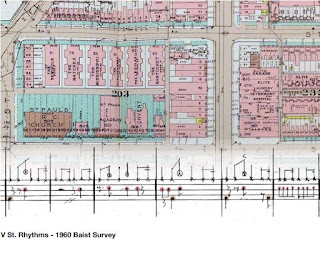 The semester ended not with a cymbal crash, but with a feeble
“end meeting for all?” prompt from Zoom. We tried to make the celebration as
celebratory as the medium would allow, but with no buffet from Bittersweet, no
one pouring Trader Joe’s best, no mixing and mingling of students, faculty,
staff, alumni, and friends in the rooms and hallways of 1001 Prince among a
year’s creative production, it just wasn’t the same. Mostly, I missed the Band.
The WAAC Band plays for all the WAAC's parties and we’re ready and open for anyone to sit in. Whatever we practiced, whatever we thought the set list
would be, the night never quite goes that way. And it’s wonderful. There is
nothing quite like the feeling of getting into a groove-- blues in E—when you
know enough about where the song might go, but not so much that you can’t be
surprised in the moment. I miss that. For all the interesting new powers that Zoom
and its cousins have provided, there is suite of joys they cannot: serendipity,
chance, improvisation.
The semester ended not with a cymbal crash, but with a feeble
“end meeting for all?” prompt from Zoom. We tried to make the celebration as
celebratory as the medium would allow, but with no buffet from Bittersweet, no
one pouring Trader Joe’s best, no mixing and mingling of students, faculty,
staff, alumni, and friends in the rooms and hallways of 1001 Prince among a
year’s creative production, it just wasn’t the same. Mostly, I missed the Band.
The WAAC Band plays for all the WAAC's parties and we’re ready and open for anyone to sit in. Whatever we practiced, whatever we thought the set list
would be, the night never quite goes that way. And it’s wonderful. There is
nothing quite like the feeling of getting into a groove-- blues in E—when you
know enough about where the song might go, but not so much that you can’t be
surprised in the moment. I miss that. For all the interesting new powers that Zoom
and its cousins have provided, there is suite of joys they cannot: serendipity,
chance, improvisation.
The WAAC Band is constantly changing personnel, adjusting to
circumstance as students and faculty come and go. What we lack in precision,
though, we make up for in enthusiasm. Sometimes we have cello player; sometimes
a banjo. This past year we had an exchange student from Japan who played
trombone. So, we made space in every song for a trombone solo. We never really
know who will show up, but someone always does.
It happens every semester: we’ll set up and start to
practice in the library (Great acoustics. Who woulda thought?) and a new
student will poke their head in with that look, a combination of longing and hesitancy.
(Admittedly, there are other looks-- the “what the heck is going on in here?
look” Or the “how do I get past the drummer to get to the Reserve Shelf?” look)
I’ll ask if they play or sing, and the answer is often yes, I play
violin/piano/guitar/drums/whatever… Then I have to ask the follow up questions:
Does the phrase “blues in E mean anything to you?” If the answer is a knowing smile
and a yes, then odds are the answer to the next question will be “no” because
the next question is: do you need notes? You know--music. Written on a staff.
In my experience, there seems to be
a correlation between knowing the blues scale and not needing notes, but it’s
not necessarily constant. I know notes; but I don't need them. I learned how to read music when I
learned how to play piano, but I was lucky to learn something else: theory. I didn’t know then
that I was learning theory. That’s not surprising: I was in middle school, and I
didn’t know much of anything. (although that’s not what I would have told you
at the time.) My unconventional, to say the least, piano teacher would hand me
a song with just lyrics and the names of chords where the changes were. She
would hum the melody and tap out the rhythm, suggest a left hand pattern, and then
tell me to play it. If I could do that, I could play anything. I learned to
regard written music the way I now see recipes, as a set of suggestions rather
than orders. As long as you understand the end goal, can see the field, there’s room for
interpretation. For improvisation.
Theory bestows the power to improvise, not merely to react to the situation. Actors will tell
you that the first rule of “improv” is that the answer to any prompt is “yes,
and…” Improv is a technique of performance, a jujitsu of accepting challenges,
a reflecting-in-action, as we
design-types might say, but at blink speed. In that sense, it may seem to be
the exact opposite of Le Corbusier’s “studio of patient research” or the methodical
retreat of a scholar’s study, or any other model of deliberate studiousness. Yet
improv demands thoughtfulness in equal measure to quickness. It is resourceful;
like a trickster making use only of the materials at hand. It is attentive and
imaginative by necessity. Improv is creativity on deadline. It’s design.
It’s hard to maintain the improvisationalist’s balance these
days because the prompts are dark and uncertain. For design, however, and those
who practice it in any form at any scale, there’s no option to refuse the
prompt. We have to answer, yes, and… Because, as singer/songwriter Paul
Brady reminds us, the world is what we make it.


